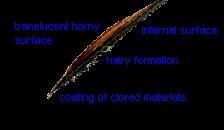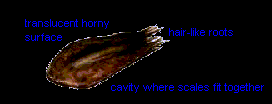|
The dragon's body is completely covered with tough, shiny scales. The only exception is the Earth Dragon, or common dragon, who does not have this scaly armor on the neck or stomach, possibly due to his habit of burrowing underground. To protect its soft abdomen, this species often wears a jeweled breastplate. Using its saliva, which has powerful adhesive properties, and which the dragon secretes on an empty stomach, the common dragon sticks precious stones on to its neck and stomach, for protection as well as adornment.
The scales are pentagonal, and shaped like a teardrop, with two long sides and two shorter ones, and a very short fifth side attached to the skin. The scales are densely packed cells made up of keratin, a tough fibrous protein. When born, a dragon's scales are as soft as tissue paper, and slowly harden while the dragon grows. The iron from the blood, or vegetable matter the dragon eats is absorbed by the dragon's blood stream and mixed with the keratin to create steel-hard scales. The process of getting scales as tough as they can get takes about one year after being hatched. The dragon can make its scales stand on end whenenever it likes, to preen them. Remember, the dragon is a very clean creature and always takes great care to keep his skin and scales clean and immaculate.
In their normal position, the scales overlap very neatly and, thanks to a tiny cavity in the surface, they fit into each other to allow perfect freedom of movement. If we study a scale closely, we observe the following characteristics: the innermost part is composed of a compact hairy formation firmly rooted in the epidermis. On the hair follicle there are some tiny glands which secrete a substance that adheres firmly to the skin. This substance is rich in minerals, which determine the hardness and the color of the dragon's scales. The external surface has a horny, translucent texture, which gives the scales their habitual luster.
CROSS SECTION 
FRONTAL SECTION 

The mercenary warrior who hired himself out to towns and sovereigns to slay dragons usually wore a suit of armor made from dragon scales. This garment gave him enormous prestige and proclaimed to all and sundry that he had slain one of these fearsome beasts. Incidentally the scales on his armor are very small, a clear indication that the dragon he killed was a young one who had barely reached puberty, and hence much easier to vanquish than an adult.
COLOR
It is impossible to list the enormous variety of hues that make up the dragon's brilliant coloring, but they can be divided into three broad color groupings: Blues, ranging from dark blue to silver and mother-of-pearl. Reds, ranging from copper red to dark red and reddish-black. Greens, which include every imaginable shade of green and yellow and even dark brown, emerald green and burnished gold. 
Many dragons are known by the predominant color of their scales. Although these three principal color groups are not usually mixed, a dragon's coloring is rarely uniform. In general, its scales are several hues from one of the main color categories, with a metallic luster which is hard to define. When the scales have a pale opaque appearance, it is a sure sign of ill health. CAMOUFLAGE 
In some breeds of dragons when the dragon is mature, the cells in the scales are able to change color due to chromatophore, the pigment cells in the scales. This reaction can be caused by emotion (anger, happiness,etc) or by the will of the dragon itself. If the dragon is angered it can change from its original color to a bright, fierce color such as red, to look more intimidating. During mating rituals it can flow certain color patterns on its body to attract other dragons. Since dragons are extremely intelligent, it can choose which colors to change into to match the exact background it is near including subtle shadows and highlights. The dragon is so good at this that most things would just walk past a 65 foot dragon hiding in the sand FLIGHT 
The actual force of flight is the continuous down sweep of powerful wings scooping, and thrusting the body upwards. An immature dragon does not have the strength needed for a vertical jump from flat ground to take off. They will usually stay near higher cliffs to use the heat updrafts to keep aloft. It takes a few years of flying to build the extremely strong flight muscles needed to lift the dragon body from the ground. The wings make actually look small for the mass of the dragon, but all dragons have an innate magic ability to help them fly. This magic helps keep dragons from straining themselves during long flights.
WEAPONS
Dragons can also use their wings as an attack weapon if need be, but this is a last resort. The wing membranes are easily damaged compared to the rest of a dragon body. If a dragon wing membrane is slashed, it takes a very long time to heal, and there is a chance the dragon might never fly again if it does not heal correctly. If attacked on the ground, the dragon will usually run then jump in the air and fly off avoiding the attacker. But if the dragon is trapped on the ground it will tuck its wings tightly against its body and use its breath weapon and claws to protect itself. If the dragon has to use its wings to attack it will scoop down and slash with its razor sharp wing claws to immobilize the attacker.
|

